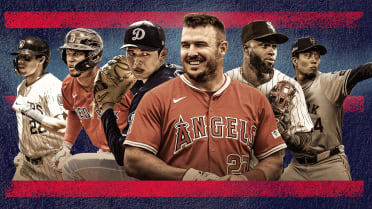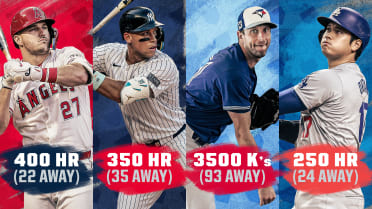MLB.com is republishing this story after Willie Mays passed away on Tuesday at age 93.
Steve and Alex Cohen released this statement: “Willie Mays was one of the greatest to ever play the game. Willie ended his Hall of Fame career in Queens and was a key piece to the 1973 NL championship team. Mays played with a style and grace like no one else. Alex and I were thrilled to honor a previous promise from Joan Payson to retire his iconic #24 as a member of the Mets in 2022. On behalf of our entire organization, we send our thoughts and prayers to Willie’s family and friends.”
NEW YORK -- There was a lot to be excited about at Shea Stadium on May 11, 1972. Not only were the Mets in first place that day, but they made news by acquiring Willie Mays from the Giants in a trade for right-hander Charlie Williams and $50,000.
This was Mays’ second go-round in New York. He was the king of the Big Apple for seven years in the 1950s when the Giants played in the Polo Grounds. Mays had millions of fans in the tri-state area, but none bigger than the Mets’ principal owner, Joan Payson.
Payson was a minority owner of the Giants and sold her stake in the team after they moved to San Francisco in 1958. When she became owner of the Mets in 1962, Payson vowed to bring Mays back to New York before his playing days ended. She made it happen on that May day. The Giants wanted to reduce payroll and Mays was one of the highest-paid players in baseball at $165,000, which made him expendable.
After learning about the trade, Mays didn’t want to play for the Mets and had plans to retire. However, Payson offered him a deal he couldn’t refuse.
“She said, ‘Write your own contract,’ and I said, ‘Whoa, I got her now.’ So I said ‘I, Willie Mays, would like to do what I want to do, when I want to do it, at any time.’ And she said, ‘Is that what you want?’ [I said], ‘Yes, ma’am.’ [She said], ‘You got it,’” Mays remembered in the HBO documentary “Say Hey, Willie Mays.”
When he joined the Mets, Mays was past his prime at 41 years old. Gone were the power numbers and the high batting average. During his two years with the Mets, Mays was hampered by a left knee injury. But to his teammates, Mays was a great addition to the ballclub, despite hitting a combined .238 with 14 home runs and 44 RBIs in 135 games.
Mays looked out for everybody on the team. If the team went out to dinner and left-hander Jon Matlack was pitching the next day, Mays would tell him, “Go home and get some sleep. You are pitching tomorrow.”
“He was a big addition to us, not because of his playing, but inspirationally, he helped all the players in the clubhouse … and tried to improve their play, and they did,” said Ed Kranepool, who was Mays’ closest friend on the team. “He was a tremendous asset to the ballclub just by being there.”
Mays and the Mets reached the postseason in 1973, and Mays managed to get big hits in October. In the pennant clincher against the Reds in the National League Championship Series, Mays entered the game in the fifth inning as a pinch-hitter for Kranepool and hit an infield single that scored Felix Millan to give New York a 4-2 lead. The Mets ended up winning the game, 7-2, and advanced to the World Series.
“When his knee wasn’t swollen and full of fluid, even at his age at that time, you saw the real Willie Mays,” said left fielder Cleon Jones. “You saw the Willie Mays of 25 and 26 years old. He was able to run the bases and play the outfield. There were times he shouldn’t have played [because of the bad knee], but he was a team player.”
With the score tied at 6 in the top of the 12th inning in Game 2 of the World Series against the Athletics, Mays singled up the middle off closer Rollie Fingers, plating Bud Harrelson and giving New York a 7-6 lead. It was Mays’ last hit of his career.
Earlier in that game, Mays had problems fielding his position at the Oakland Coliseum. It didn’t help the sun was in his eyes, but even with his sunglasses on, he was having issues.
The problems started in the bottom of the ninth inning with the Mets up, 6-4. Deron Johnson led off and hit the ball to left center field. It looked as if Mays had a bead on the ball, but he slipped and fell while the ball went past him for a stand-up double. Oakland soon tied the score on a single by Gene Tenace.
After the Mets took a 10-6 lead in the top of the 12th, Mays’ problems in the outfield resurfaced. Reggie Jackson led off and hit the ball to deep left-center field. Mays couldn’t see the ball and it bounced in front of the wall for a triple. Jackson later scored the last run of the game on a single by Jesus Alou.
To most who saw the game that day, it was assumed that Mays’ age and his balky left knee betrayed him, but he wasn’t the only player who had problems with the sun. Jones and A’s left fielder Joe Rudi had problems, also.
“The sun was terrible at that time. You can’t do anything about that,” Kranepool said. “It had nothing to do with age or anything else. When the ball goes in the middle of the sun and it’s bright enough, glasses don’t help anybody, whether you are 20 years of age or 40 years of age. If you can’t see the ball, you can’t catch it. Anything Willie got close to, he was going to catch. It was just the ball blocking his vision.”
Jones remembers looking for better sunglasses to shield the sun, but nothing was better than what he already had.
“We didn’t have anything and we didn’t know about the sun and nobody talked about it,” Jones said. “People looked [at his age], but I didn’t look at it as something that was demeaning to Willie Mays.”
The Mets lost the Fall Classic in seven games to Oakland, which was the end of Mays’ playing career. He had already announced in September that he was going to retire after the season, and he officially hung up his cleats after Game 2 while the World Series was still going on. But his teammates wanted him to continue his playing career.
“I thought he had a lot left in him. He was 42 and he was still the best player on our team," Jones said. “We know everybody has to retire at some point, but I thought he could have played forever. He was so much a part of baseball -- his style of baseball, what he brought to baseball. I can’t think of another person besides Babe Ruth that brought more to the game than Willie. No doubt, Willie was the greatest player in my lifetime. That’s not taking anything away from Hank or anybody else.”
Bill Ladson has been a reporter for MLB.com since 2002. He covered the Nationals/Expos from 2002-2016.




